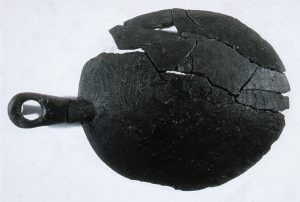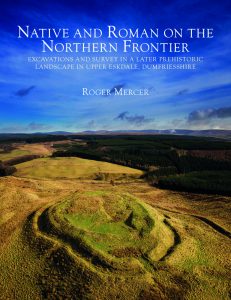In March 2018, Roger Mercer’s Native and Roman on the Northern Frontier was published, presenting the definitive account of excavations at two major sites in Dumfriesshire: the Castle O’er hillfort, and an enclosure at Over Rig. Here, the author tells us a little bit about the book and the excavation behind it.
1. How would you describe your book in a single sentence?
It demonstrates how archaeological fieldwork and its results can create an informed picture of a prehistoric landscape, as well as its people and their economy.
2. How did you become involved in the excavations in Upper Eskdale, Dumfriesshire?
The site was thought to be under threat from erosion by the River Esk and was sufficiently unusual that the Historic Buildings and Ancient Monuments Division of the Scottish Development Department [now Historic Environment Scotland] asked me to investigate it. A larger project was built around this investigation in order to set the site into its social and environmental context.
3. What is the significance of this particular site?
The site transpired to be of a hitherto unrecognised type, and appears to be a place of auditorial assembly for large numbers of people. It would have been in use shortly after the appearance of Roman forces in the area following the establishment of Roman dominance in what is now northern England. Such assemblies may have been associated with the use of a complex range of what are apparently stock enclosures possibly facilitating the transfer of animals to feed the incoming garrison.
4. How does this site contribute to our understanding of the Scottish Iron Age?
The account of the excavations seeks to clarify the relationship and interactions between native farmers and the invader, which would have been complex and nuanced.
5. What was the most significant find from this site?
The most beautiful find was undoubtedly a finely carved wooden skillet found perfectly preserved in the waterlogged ditch of the site.
6. What was the most surprising find from this site?
For me, the recognition by Dr Richard Tipping of pollens of nitrogen-fixing crops like sainfoin and rape in the palaeo-environmental record. These are usually associated with the ‘Agricultural Revolution’ of the 17th-18th century, but were identified in 12th-13th century deposits having presumably been introduced by Cistercian monks. A wholly unrelated discovery to the main focus of the project!
7. What were the challenges involved in preparing the excavations for publication?
Largely the problems of recall after the unfortunate delay between carrying out the fieldwork in 1984 /1985 and preparing the results for publication thirty-odd years later. Fortunately the excavation notes were excellent. Mea culpa.
8. What current developments/research in the Scottish Iron Age are you most excited by?
The evidence that accrues almost monthly for our enhanced appreciation of the sophistication and far-reaching contacts of pre-Roman societies in Scotland.
You can order Native and Roman on the Northern Frontier from our our online shop now. Keep an eye on our events page to attend a lecture by the author later this year.



